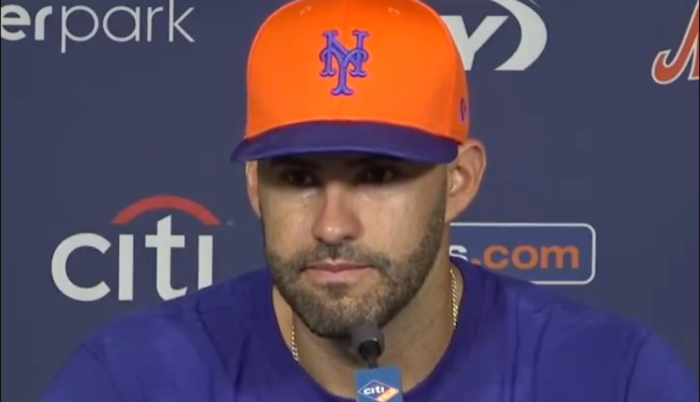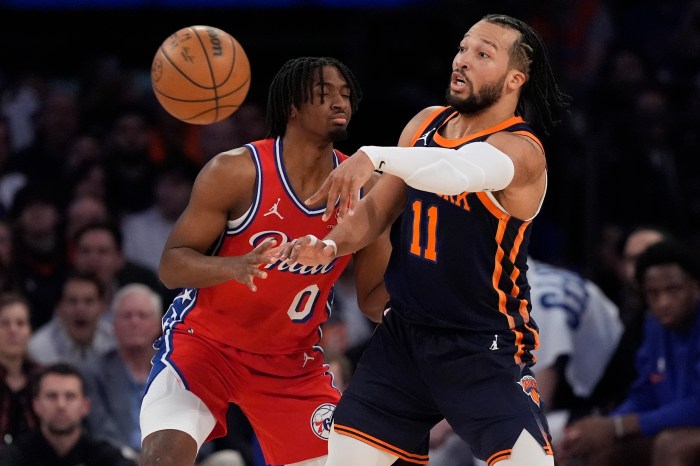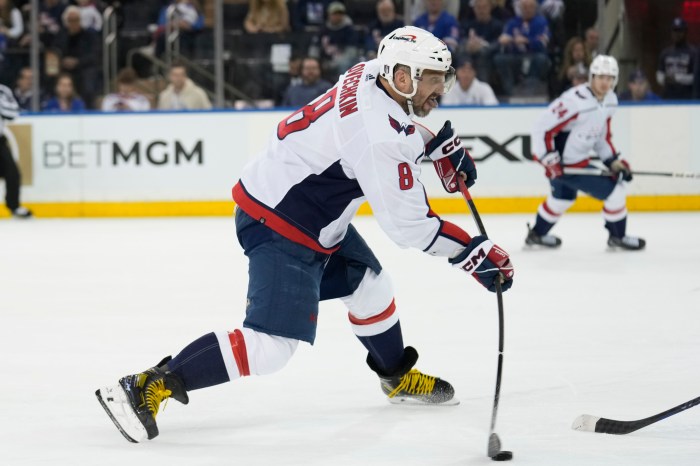 FIRST GAME IN BROOKLYN
FIRST GAME IN BROOKLYNNov. 26, 2012
Brooklyn had missed its professional sports teams. In front of a sellout crowd that was split between Knicks and Nets fans, Brooklyn came out on top, 96-89, in overtime. Carmelo Anthony dropped 35 points on the Nets, but Brook Lopez and Deron Williams both had double-doubles, showing whose starting five has the leg up. | ” class=”wp-image-14266624″/>
Nov. 26, 2012
Brooklyn had missed its professional sports teams. In front of a sellout crowd that was split between Knicks and Nets fans, Brooklyn came out on top, 96-89, in overtime. Carmelo Anthony dropped 35 points on the Nets, but Brook Lopez and Deron Williams both had double-doubles, showing whose starting five has the leg up. | Photo Credit: Richard Harbus
The Knicks and Nets, teams which had championship aspirations back in November, were forced to sit idly by as the Spurs won their fifth NBA title in 15 years. In an era that has seen teams such as the 2012 and 2013 Heat and the 2008 Celtics pull in big stars through free agency to attain glory, San Antonio’s model has been to build through the draft and make the principal players buy in to the system.
It’s not as if the Spurs are littered with ex-lottery picks, either. Yes, Tim Duncan is one of the best No. 1 overall picks ever. But after him, the rest of their core were drafted outside the lottery. There’s Tony Parker (No. 28 in 2001) and Manu Ginóbili (No. 57 in 1999), who were on four of the title teams. Finals MVP Kawhi Leonard was taken 15th by the Pacers in 2011, but traded immediately to the Spurs. Even Tiago Splitter went 28th to the Spurs in 2007. And then there are key contributors like Patty Mills and Danny Green, both late second-round picks in 2009 by other clubs who then cast them away.
The bottom line is this: The Spurs have maintained an elite level in this sport thanks to talent evaluators capable of spotting diamonds in the rough. If the New York NBA teams want to win, they would be wise to invest in scouting and in young talent.
There are helpful players to be found in the draft — that is, when a team has a draft pick, which neither the Nets nor Knicks possess this year. The problem for both local clubs has been finding and retaining those players.
During the past 10 drafts, the Knicks have taken Trevor Ariza, Wilson Chandler, Danilo Gallinari, Jordan Hill and David Lee, with only Hill and Gallinari being selected earlier than 23rd overall. They’re all contributors right now for other teams, with Lee a two-time All-Star.
The Nets have identified their fair share of talented young players in that time, too. They’ve kept Brook Lopez and Mason Plumlee, but parted ways with the likes of Ryan Anderson, Jordan Crawford and Derrick Favors.
Both teams have whiffed, too, missing out on some excellent players selected later in the draft. In 2004, the Nets used the 22nd pick on Viktor Khryapa, who no longer plays stateside. Talented scorer Kevin Martin went a few picks later, as did defensive studs Tony Allen and Anderson Varejao.
Two years later, the Knicks opted for Renaldo Balkman at No. 20. Quality point guards Rajon Rondo and Kyle Lowry were taken in the next few picks, and All-Star forward Paul Millsap was the 47th overall pick. Balkman, who plays the same position as Millsap, has been out of the league for two years.
With the Knicks and Nets in draft purgatory for the next couple of years, utilizing the remaining selections they will have wisely and then keeping that talent in the fold will be key to building a lasting winner New York can get behind.
Scott Fontana, amNY’s sports editor, can be reached at scott.fontana@am-ny.com.

















